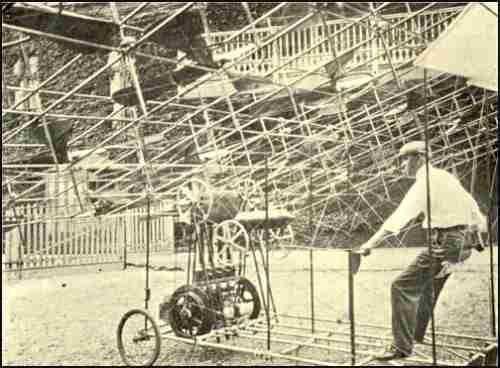
| The Aeronautic Society of New York |
|
THE first machine to be laid down was a helicopter by Wilbur R. Kimball, which was an interesting and valuable experiment to solve a number of great problems that could not be satisfactorily proven in models. One of these was the proof that it was possible to obtain very large propeller blade area with a minimum of weight by using a number of propellers. Mr. Kimball tried twenty propellers, representing a total blade area of 320 square feet, but which, with their enclosing frames weighed only 112 lbs. It was clearly demonstrated that the same surface area could not possibly be obtained in two propellers which, with their supporting surfaces, would weigh so little. Another was the attempt to obtain at once both sustaining and driving force by an inclination of the axes of the propellers. A third dealt with the possibility of obtaining fore and aft equilib- rium by shifting the weight of the operator's body as the need arose, in conjunction with a rear horizontal rudder. A fourth was to try out the question of whether, rather than to attempt to lift directly into the air, it would not be easier to rise with a running start on undisturbed air. Mr. Kimball has throughout been one of the most earnest and enthusiastic workers. His work has always been extremely interesting, because he has always taken in hand some one of the most difficult of problems, and, in addition, has dealt with it in an entirely original manner. In this way, indeed, he has often made difficulties for himself, which have delayed the main object in view. For when a difficulty has arisen he has never left it or put it aside until he had straightened it out. |
 |
|
For his helicopter, Mr. Kimball had obtained a very light and remarkable motor, one of the first that was ever built in this country specially for aeronautical purposes, designed by Mr. Geo. J. Altham. It was a four cylinder, 4 in. by 4 in. two-cycle engine, develop- ing 50 h. p. at 2,000 r.p.m., and weighing, with water-cooling system and magneto, 180 lbs. However, it could then be run only at very high speed, and, though admirably suited for an aeroplane, did not answer for the very intricate transmission required to drive twenty |
|
|